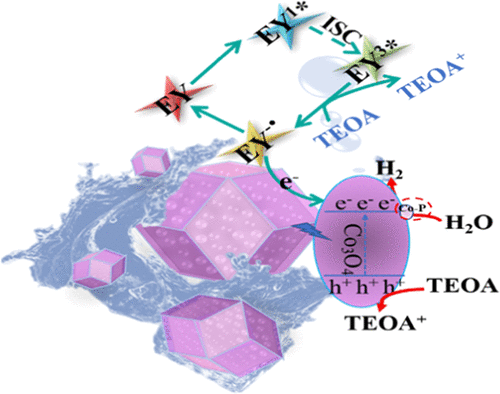当前位置:
X-MOL 学术
›
ACS Appl. Mater. Interfaces
›
论文详情
Our official English website, www.x-mol.net, welcomes your
feedback! (Note: you will need to create a separate account there.)
Zeolitic Imidazolate Framework-67-Derived P-Doped Hollow Porous Co3O4 as a Photocatalyst for Hydrogen Production from Water
ACS Applied Materials & Interfaces ( IF 8.3 ) Pub Date : 2021-10-22 , DOI: 10.1021/acsami.1c14987 Lijun Zhang 1 , Zhiliang Jin 2 , Noritatsu Tsubaki 1
ACS Applied Materials & Interfaces ( IF 8.3 ) Pub Date : 2021-10-22 , DOI: 10.1021/acsami.1c14987 Lijun Zhang 1 , Zhiliang Jin 2 , Noritatsu Tsubaki 1
Affiliation

|
As a part of photocatalytic water splitting, the design of low-cost, high-activity catalysts plays an essential role in the development of photocatalytic water splitting. Metal oxides have the advantages of a wide range of sources, many varieties, and easy preparation. Doping engineering on their surface can construct new active sites and adjust their catalytic activity. In this work, a new strategy was developed through anion hybridization to regulate electron delocalization. Using one of the cobalt-based zeolitic imidazole skeletons (ZIF-67) as a precursor material, a two-step calcination method was used to prepare a P-doped Co3O4 mixed anion composite photocatalyst. The hydrogen production rate of P@Co3O4 is 39 times that of ZIF-67 and 6.8 times that of Co3O4. Through density functional theory (DFT) calculations, the electron delocalization state of the sample surface is predicted and the reaction energy barrier is reduced to promote the process of the hydrogen evolution reaction (HER). The special O(δ−)–Co(δ+)–P(δ−) surface bonding state promotes the bridging of isolated electronic states and provides active sites for the adsorption and activation of reaction substrates. The improved electron transport pathway and the synergy between the catalytic sites under the high electron transport rate are the main reasons for the enhanced photocatalytic hydrogen evolution activity. This strategy, including changing the surface bond state and optimizing the structure and composition of the catalyst not only provides a new method for preparing other MOF-derived nanomaterials with porous structures but also inspires the reasonable development of other MOF-based advanced photocatalysts.
中文翻译:

沸石咪唑酯骨架 67 衍生的 P 掺杂中空多孔 Co3O4 作为光催化剂从水中制氢
作为光催化水分解的一部分,低成本、高活性催化剂的设计在光催化水分解的发展中起着至关重要的作用。金属氧化物具有来源广、品种多、制备容易等优点。在其表面掺杂工程可以构建新的活性位点并调整其催化活性。在这项工作中,通过阴离子杂化开发了一种新策略来调节电子离域。以钴基沸石咪唑骨架(ZIF-67)之一为前驱体材料,采用两步煅烧法制备了P掺杂的Co 3 O 4混合阴离子复合光催化剂。P@Co 3 O 4产氢率是 ZIF-67 的 39 倍和 Co 3 O 4 的6.8 倍. 通过密度泛函理论(DFT)计算,预测样品表面的电子离域状态,降低反应能垒,促进析氢反应(HER)过程。特殊的 O(δ-)-Co(δ+)-P(δ-) 表面键合态促进了孤立电子态的桥接,并为反应底物的吸附和活化提供了活性位点。改进的电子传输途径和高电子传输速率下催化位点之间的协同作用是光催化析氢活性增强的主要原因。这个策略,
更新日期:2021-11-03
中文翻译:

沸石咪唑酯骨架 67 衍生的 P 掺杂中空多孔 Co3O4 作为光催化剂从水中制氢
作为光催化水分解的一部分,低成本、高活性催化剂的设计在光催化水分解的发展中起着至关重要的作用。金属氧化物具有来源广、品种多、制备容易等优点。在其表面掺杂工程可以构建新的活性位点并调整其催化活性。在这项工作中,通过阴离子杂化开发了一种新策略来调节电子离域。以钴基沸石咪唑骨架(ZIF-67)之一为前驱体材料,采用两步煅烧法制备了P掺杂的Co 3 O 4混合阴离子复合光催化剂。P@Co 3 O 4产氢率是 ZIF-67 的 39 倍和 Co 3 O 4 的6.8 倍. 通过密度泛函理论(DFT)计算,预测样品表面的电子离域状态,降低反应能垒,促进析氢反应(HER)过程。特殊的 O(δ-)-Co(δ+)-P(δ-) 表面键合态促进了孤立电子态的桥接,并为反应底物的吸附和活化提供了活性位点。改进的电子传输途径和高电子传输速率下催化位点之间的协同作用是光催化析氢活性增强的主要原因。这个策略,















































 京公网安备 11010802027423号
京公网安备 11010802027423号